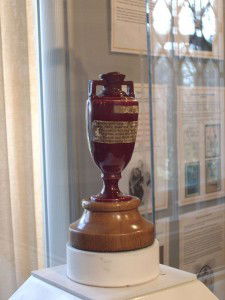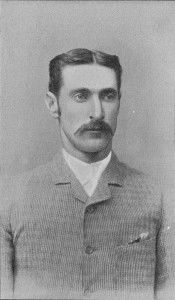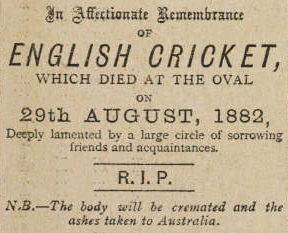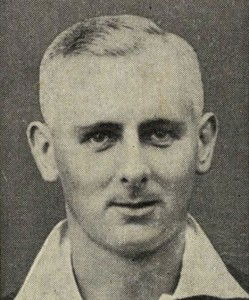
via Imago
Ashes Urn
1882
Watch What’s Trending Now!
Ashes began with an Australian victory and a bail burnt in horror. But only by its narrowest definition are the Ashes about a sporting contest or the spurious contents of a miniscule urn.
ADVERTISEMENT
Article continues below this ad
It is often said about Test matches that they are won only if the team has the capability to take 20 wickets in less than 5 days. Over it’s entire course of history, Ashes has produced several bowling performances that have etched themselves in history books. We have a look at the top 10 bowling spells in Ashes.
ADVERTISEMENT
Article continues below this ad
http://https://www.youtube.com/watch?v=G-YHaPJBqzw
Glenn McGrath is perhaps the finest fast bowler to play the game. The young Glenn McGrath was described by Mike Whitney as “thin – but Ambrose-thin, not Bruce Reid-thin”. Much later, Mike Atherton compared McGrath to Ambrose on a vaster scale. Catapulted from the outback of New South Wales into Test cricket to replace Merv Hughes in 1993, McGrath became the greatest Australian fast bowler of his time. He went on to beat Courtney Walsh’s 519 wickets in the 2005 Super Test to become the leading wicket-taker among fast bowlers and his claim to the title of Australia’s greatest fast man is contested only by Dennis Lillee.
Coming into the 2005 Ashes, Glenn McGrath had a long time to think about how he might get his 500th Test wicket but when it came he didn’t dwell on it.
After finishing his previous series on 499 scalps, McGrath had plenty to look forward to – almost like an expensive meal at a favourite restaurant – and who he might devour played a major role in Fox Sports’ ads ahead of the series.
ADVERTISEMENT
Article continues below this ad
McGrath took his then best figures of 8-38 in 1997 at Lord’s, ripping out the top order and then the tail, and it was there again in 2005, later on the first day of the first Test match, that he got his chance to break through 500.
After getting Marcus Trescothick to edge to Justin Langer at third slip, McGrath held the ball aloft to mark the milestone and then got right back to work. After 13 overs bowling down the slope from his beloved Pavilion End, McGrath had reduced England to rubble with 5-21.
“I couldn’t have hoped for a better opening start to the Ashes series, and for me personally that first spell was probably up there with the best spells I have ever bowled,” McGrath said.
http://https://www.youtube.com/watch?v=tb9N0vlUFys
The 2005 Ashes series has been labeled as one the best. After crushing England in the first Test match, Australia looked out to get a 2-0 lead against England. Luck was with England during that test, because Glenn McGrath, Australia’s best bowler, slipped over a cricket ball before the match started and was ruled out. Things went well for England as they went on to make 407 runs in their first innings, with Trescothick, Flintoff, and Pietersen completing half-centuries.
The Aussie’s could not have dreamed of a worse start. In the second over of their first innings, Australia lost Matthew Hayden on a 5 ball duck. The situation required the Australian captain, Ricky Ponting, the best batsmen of the time to come and play a sensible knock and that’s what he did, scoring a fluent 61 as Australia put up 88 runs for the 2nd wicket partnership. Justin Langer top scored the Australian innings with a steady 82, while wicket-keeper Adam Gilchrist was not out at 49 as England managed to bowl out the Australians for 307, maintaining a lead of 100 runs.
In the 2nd innings, England managed to score a meager 187, as the spin master Shane Warne took 6/46 in 23.1 overs with England looking intent on throwing it all away. Although Lee and Warne bowled like demons (Lee taking three wickets in 11 balls for just four runs), some senior England batsmen were guilty of poor shots. Trescothick wafted outside off stump and edged to Gilchrist, and Vaughan was once again bowled through the gate for 1. When Hoggard joined them in the pavilion, England were 31-4 and behind in the match for the first time. After less than 15 overs, Australia were on top.
Bell and Pietersen steadied the ship before both fell to Warne. With the score at 75-6, Jones joined Flintoff at the crease. Jones was out for nine just after lunch and Flintoff was England’s last recognised batsman left. Warne removed one English batsman after another but Flintoff dug in, despite being in considerable pain. As Warne removed Steve Harmison when England’s score read 131-9, Flintoff got going. He blasted Brett Lee all over the park but was eventually bowled by Warne on 73 runs to give him an impressive bowling figure of 6/46.
Although, Australia lost that match thanks to some brilliant all-round cricket by Englishman Andrew “Freddie” Flintoff, it was Warne’s magic with his fingers in the 2 innings which kept Australia in the test right till the end and made Edgbaston, 2005, one of the best Ashes test match ever played.
http://www.youtube.com/watch?v=rjSDvdgTOzg
An icon of the modern era, Ian Terence Botham seemed to save his best for England’s biggest rivals. He was loved by the spectators and the press for differing reasons. The all-rounder at times resembled Superman on the field; Botham had the capabilities to do special things in all three aspects of the game, turning matches around with a whirlwind innings with the bat or by sending down a devastating spell with the ball.To top it all off, he was one of the best slip fielders ever seen, catching balls in the air with the minimum of fuss.
By the time he finally finished his stellar career he had scored over 5,000 Test runs and taken 383 wickets (he had held the world record at one stage and still is England’s top wicket-taker).
However, he is best remembered for one series against Australia in particular, helping England rise from the depths of despair to win what would be known as ‘Botham’s Ashes’.
He resigned from captaincy after picking up a pair in a tame draw at Lord’s, and later became a man possessed for the rest of the summer under the leadership of Mike Brearley. He cracked 149 runs to turn around what seemed a certain lost cause at Headingley (the bookies had odds of 500-1 on a home win during day three) and then took 5-1 in 28 balls at Edgbaston to deny the Aussies a victory yet again.
In the Edgbaston Test, Australia needed 151 runs to win and were 114 for 5. In comes Beefy. Having rediscovered his mojo at Headingley, Botham had gone back into his shell at Edgbaston. A 43-ball 26 and an 11-ball 3 had sandwiched a largely fruitless spell of one for 64 in the Australian first innings. His nine overs in the first spell of the second innings had been frugal, with just 10 runs conceded, but wicket-less.
With the third ball of his new spell, tables turned in his favour. Rodney Marsh swung across the line and lost his middle stump. “The crowd has gone noisily berserk”, noted Richie Benaud on the TV commentary. And the 10,000 people in Birmingham were still roaring as Botham charged in and trapped Bright- Leg before wicket with his next delivery. Botham missed the hat-trick as Lillee jabbed the next ball, but was soon caught behind by a juggling Taylor. Martin Kent was bowled off his pads attempting an ill-advised hoick to leg while Alderman played and missed three balls, the last of which saw him castled. Botham’s figures for the spell read 5-4-1-5 and Australia had crumbled from 105 for four to 121 all out.

via Imago
Fred “The Demon” Spofforth
This is where it all began, back in 1882.
This particular test match at Kennington Oval was a low scoring affair. 4 balls constituted 1 over and the match was officially a 3 day battle. There were only 13 double-digit scores in all the 4 innings combined and by the end of day 2, Australia had won the match.
After winning the toss, Australian captain, WL Murdoch, elected to bat first. 80 overs and 133 minutes of ordeal later, Australia was bundled out for a paltry 63. England didn’t do themselves any good either. They were bowled out for 101 in 71.3 overs, FR Spofforth with an impressive bowling figure of 7/46. With England leading by 38 runs, HH Massie took it upon himself to lead the charge. He smashed a 57 ball 55 runs innings and was the highest run-getter in the match. With the departure of the opener, only captain Murdoch showed some strength as he stood almost till the end of the innings, scoring 29 runs and dragging Australia to a total of 122 runs.
The Australians were greatly demoralized by the manner of their second-innings collapse, but the fast bowler Fred Spofforth refused to give in. “This thing can be done,” he declared. Chasing, a target of 85 runs, England were cruising at 51-2 when the devil Spofforth hit them yet again. Having already removed the first two wickets of captain Hornby and then the No. 3 batsman Barlow on consecutive balls when England only had 15 runs on the board, he came back to haunt them as he ran right through the English batting line up like a behemoth drilling down a mountain. Spofforth went on to devastate the English batting, taking his final 4 wickets for only 2 runs to leave England just eight runs short of the victory. England slumped from 51-2 to 77 all out with Fred Spofforth and Harry Boyle cleaning up the last 5 English batsmen in a space of 13 deliveries and a matter of just 17 minutes. Fred Spooforth returned with bowling figures of 7/44 and Boyle got 3/19 in the 2nd innings.
A stunned Oval crowd fell silent, struggling to believe that England lost to a colony on home soil. When it finally sank in, the crowd swarmed onto the field, cheering loudly and chairing Boyle and Spofforth to the pavilion.
“Demon” Fred Spofforth and Harry Boyle’s inspired bowling delivered Australia their first Test match victory over England at the Kennington Oval. Dismissed for 77, England had implausibly lost by seven runs, and so devastating was the defeat the Sporting Times penned a sardonic, but an unforgettable obituary.

And Ashes was born.

via Imago
Hedley Verity
A victim of World War II, Hedley Verity was a professional cricketer who played for Yorkshire and England between 1930 and 1939. A slow left-arm orthodox bowler, he took 1,956 wickets in first-class cricket at an average of 14.90 and 144 wickets in 40 matches at an average of 24.37. Named amongst the Wisden Cricketers of the Year in 1932, he is regarded as one of the most effective slow left-arm bowlers to have played cricket. He achieved success through the accuracy of his bowling. On pitches which made batting difficult, particularly ones affected by rain, he was almost impossible to bat against.
In the 1934 season, the Australians toured England and Verity was selected for all five Test matches. Australia won the first game—Verity took two wickets. In the second match at Lord’s, England scored 440 in their first innings but after the second day’s play, Australia were well positioned, having reached 192 for two wickets. Verity was the only bowler to trouble the batsmen and had caught and bowled Sir Don Bradman. After rain fell overnight, the pitch played helpful to the spinners. On the third day, Australia lost their last eight wickets while scoring just 92 runs. Verity took six of those wickets to achieve a bowling figure of 7-61. The tourists just failed to score enough runs to make England bat again and were forced to follow on. Cardus wrote: “Verity settled the issue like a great bowler”.
When Australia batted again, Verity took eight for 43, dismissing Bradman a second time, to give him match figures of 15 for 104; 14 of which came on the third day. Cardus believed that the Australian batsmen played very poorly against Verity’s spin, while the Wisden correspondent wrote: “This amazing achievement would probably have been only possible to a man possessed of such length and finger-spin as Verity … Verity’s length was impeccable and he made the ball come back and lift so abruptly that most of the Australians were helpless. The majority of them had had no experience in England of such a pitch, and they showed no ability or skill in dealing with bowling like that of Verity under these conditions; their efforts at playing back were, to say the least, immature.”
Afterwards, this game became known in cricket circles as “Verity’s match”; it was the only occasion in the 20th century when England beat Australia at Lord’s.
P.S. – In 1932, Verity gave a perfect 10/10 performance for Yorkshire in a first-class match against Nottinghamshire as he achieved a world record bowling figures of 10/10 in second innings. He spun the ball sharply and took seven wickets in 15 deliveries, including a hat-trick. His bowling figures of 10 for 10 beat the previous record for fewest runs conceded while taking all 10 wickets, and this remains, as of 2015, the best bowling analysis recorded in first-class cricket.
“This ground was tailor made for my style.”- Glenn McGrath
http://www.youtube.com/watch?v=6pQBzckYG8w
This is McGrath’s second entry in the top 10 and again from the pitch of Lord’s. McGrath’s record at Lord’s is simply superb.
One of the most successful exponents of the Lord’s slope, McGrath’s 8/38 on his first Test at the ground during the 1997 Ashes series is among the finest spells of bowling ever witnessed by a crowd at the Home of Cricket.
Overcast conditions in London provided a handy backdrop to McGrath’s demolition job of England at Lord’s back in 1997, with Mark Taylor electing to send England into bat after day one had been completely lost to rain. Taylor didn’t have to wait long to prove his decision correct.
Utilizing the conditions at a venue he always loved to ball throughout his decorated career, McGrath found his rhythm and set out to systematically dismantle the England batting order.
In fact, it was the rain that got in his way, with the day two cut short after McGrath had ripped out the hosts’ top three – Mark Butcher, Mike Atherton and Alec Stewart – for a combined total of seven runs.
Mike Atherton, Mark Butcher, Alec Stewart and co. had no answer to McGrath, who, at the first bite of the cherry, had his name up on the famous Lord’s Honours Board.
The Australia speedster returned the next morning in equally devastating form, taking another five wickets to finish with 8-38; the best innings figures in an Ashes Test at Lord’s. England was bowled out for 77 – their lowest total at the Lord’s in the 20th century.
“This ground was tailor made for my style of bowling,” the New South Wales man told Lord’s TV. “If I could pick this wicket up and put it in my pocket and take it anywhere in the world, then happy days”.
McGrath’s 8/38 remains the best figures in an innings by any visiting bowler at the Ground.
https://www.youtube.com/watch?v=zZzWcfg4_sc
This bowling spell was a part of The Botham Ashes and it was Ian Botham’s stock of dry cider (and not his fierce bowling spell or his swashbuckling hitting) coupled with the threat of an international scrapheap, which fired up Englishman, RGD Willis, for the bowling performance he is best remembered for.
However, his finest hour – in the Headingley Test of 1981 – came against an unlikely backdrop.
England was already 1-0 down going into that Third Test, Beefy had been axed as the captain and Willis had actually been dropped because the selectors didn’t think he was fit.
Happily, he was given a late reprieve, but England was forced to follow-on and was facing an innings defeat on the Saturday night, heading into the Sunday rest day.
“We were looking down the end of the barrel and the senior players were thinking ‘this could be the end of our careers’”, recalled Willis.
But then Beefy scored 149 not out and England were defending 130 for a victory while Willis was bowling for his Test match life. He wasn’t given the new ball and the Australians reached 52-1. Then he switched ends and Brearley said: ‘Forget about no balls, just bowl as fast as you can’.
The pitch was deteriorating and the ball was spitting off just short of a length. England picked up three wickets before lunch and started to believe the pressure was shifting on to the Aussies. Mike Gatting took two very good catches; there was a great slip catch by Botham to dismiss Captain Kim Hughes and another from Graham Dilley out on the boundary to account for Rod Marsh. Everything came together and the Aussies just wilted under the pressure.
Chris Old put a catch down at slip but Ray Bright’s middle stump came out of the ground for the final wicket.
England had won by 18 runs and Bob Willis had taken 8-43.
https://www.youtube.com/watch?v=YzhzQiW4rtY
Mitchell Johnson has bowled a few memorable spells in this decade, to say the least (remember 12 wickets of lethal pace at Centurion, where he broke Ryan McLaren’s arm?). However, when England came to face the Aussies down under in 2013, little did they know whom they were running into. Mitchell Johnson had been in a fiery mood and he took 9 wickets at Brisbane to rattle England in Australia’s first home Ashes Test; and 8 more at Melbourne when the tourists’ spirits had flagged. But it was at Adelaide where the Ashes had to be virtually won or lost and Johnson produced his most destructive single spell of the Ashes, a 7/40, on a flat deck.
It was a blood curdling display of world class fast bowling by Johnson on a dead pitch for bowlers as he took 5/16 in five overs immediately after lunch to leave England in a state of bewilderment. England lost their last seven wickets for just 61 runs in a wholesale collapse which was as bad as any they had suffered.
Johnson’s second over after lunch did the most damage: Ben Stokes, Matt Prior and Stuart Broad falling in the space of five balls. Johnson missed the hat-trick when Graeme Swann chipped the first ball of his next over not too convincingly through midwicket. He fended off a nasty bouncer in Johnson’s next over before driving desperately and falling to a fast catch at first slip by Clarke. The finest piece of theatre was reserved for Anderson, whose middle stump was removed first ball.
Johnson finished with 7 for 40, twice on a hat-trick, with England’s lower order entirely unable to cope with a perpetual assault above 90mph; and potent slingers from a heavily muscled, koi-fish tattooed left arm.
The Surrey off-spinner’s performance at Old Trafford in 1956, when he took 19-90, immortalised him forever in Ashes lore (he also took 11 wickets in the previous Test and seven in the next). Jim Laker’s Austrian wife asked him as he returned home from Manchester: “Jim, did you do something good today?” after she had taken a series of congratulatory phone calls. He took 79 Ashes wickets in total at 18.27 apiece.
Australia had seen their 19-year hold on the Ashes ended in 1953 and been somewhat battered on home soil by Len Hutton’s tourists in 1954-55. This was not a dominant Australian team of the immediate postwar era, but still the one stacked with talent. In 1956, Laker with his troubling off-spin was weaving a web of magic around the bewildered visitors. 3 Test matches gone, the Ashes series was leveled at 1-1.
Next stop, Old Trafford, Manchester.
By lunch on Day 2, England had accumulated 459 runs. Australia’s reply began steadily, with Colin McDonald and Jimmy Burke putting on 48 runs for the opening wicket. The England spinners Laker and Tony Lock had been bowling in tandem but had enjoyed as little success as the Australian pair. That was until just before tea, when Peter May opted to switch the pair around, and Laker began bowling from the Stretford End.
McDonald was first to go, but perhaps the key wicket was the next, that of Neil Harvey. “That Shane Warne delivery that bowled Mike Gatting, well, that wasn’t in the same class,” said Harvey, the left-hander who was clean bowled for a duck by the one that pitched on leg and hit the top of off stump, from round the wicket.
After the tea break wickets came in a deluge, with Lock taking the wicket of Burke and Laker taking the other seven. Australia were utterly flummoxed and collapsed from 48 without loss to 84 all out. Laker’s figures read 16.4-4-37-9 and England enforced the follow on.
Same Test. Same story. 2 innings.
After enforcing a follow-on, England resumed the innings but Australia dug in to reach 53 for one by the close of the Day’s play, the only wicket to fall that of Harvey. On the following day only 45 minutes were possible because of the rain, but that was all that Laker needed to take the wicket of Burke. Sunday, the rest day, was gloomy and grey but by Monday the rain had ceased, and the uncovered pitch, which had been a dustbowl on the opening two days, was as wet as an otter’s pocket. Cold winds replaced the rain and only an hour’s play was possible with Australia edging to 84 for two.
That gave England only the final day to take 8 wickets and with that an unassailable 2-1 lead in the series. Tuesday morning was fine and dry and on a lifeless pitch the tourists added another 28 runs before lunch. Then came the sun and with it the alchemy that turned the track. “It started on sand and it finished up on mud,” said McDonald. Laker took full advantage.
His bowling remained magical. “There were people trying to get down the track to him, people trying to play him off the back foot, people trying to smother the spin,” said Benaud. “We had thought long and hard about it and we were trying everything we knew.” It was to no avail. The wickets tumbled to Laker while, at the other end, Lock pushed his deliveries through faster and faster in frustration.
Finally, in Laker’s 52nd over, came his 10 scalp, with Maddocks trapped in front. He finished with barely-believable second-innings figures of 51.2-23-53-10 and those epic, history-making match figures of 19 for 90.
Edited By Shivang Aggarwal
ADVERTISEMENT
ADVERTISEMENT
ADVERTISEMENT
ADVERTISEMENT




